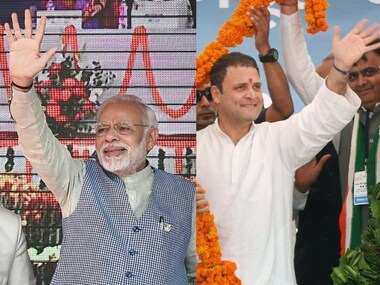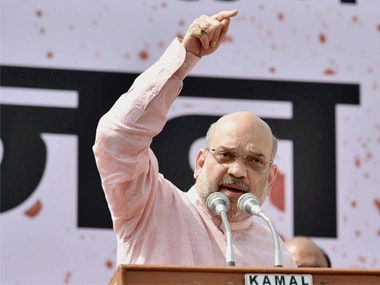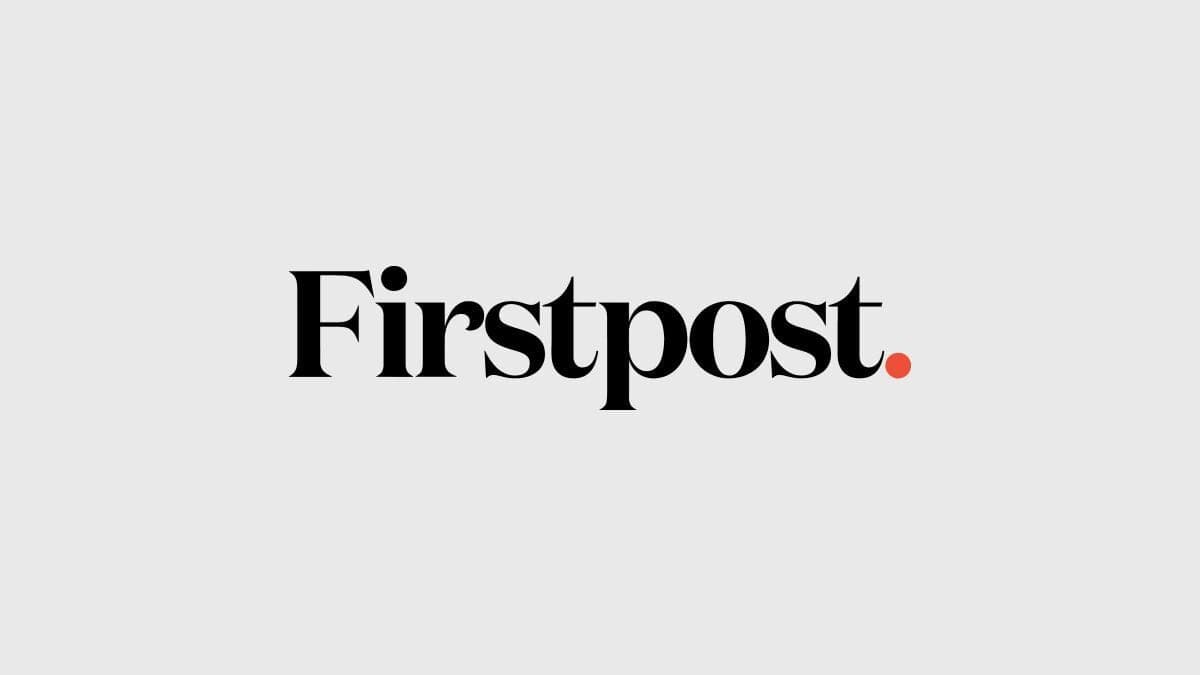Prime Minister Narendra Modi would handily beat Congress president Rahul Gandhi in a one-on-one contest, according to a new C-Voter survey poll. This poll, part of the largest and definitive independent sample survey tracker series carried out in India over the past 22 years by C-Voter, was conducted between the third week of December 2017 to the third week of January 2018 and has a sample size of over 10,000 respondents.
Sixty-six percent of the respondents preferred Modi as prime minister, while just 28 percent of respondents chose Rahul Gandhi as prime minister. Six percent chose none of the above. In 2017, 69 percent of those surveyed picked Modi over the Gandhi scion, who was chosen by only 26 percent of respondents.
| NaMO vs RaGa:Who would you prefer as PM? | 2017 | 2018 |
| Narendra Modi | 69% | 66% |
| Rahul Gandhi | 26% | 28% |
| None of them | 5% | 6% |
| Total | 100% | 100% |
According to the respondents, Modi remains the most suitable candidate for prime minister far ahead of Rahul Gandhi, Sonia Gandhi, Manmohan Singh, Arvind Kejriwal, Nitish Kumar, Mamata Banerjee, and Mulayam Singh. Modi received the nod from 62.7 percent respondents, 12.6 percent said they would prefer Rahul, 4.4 percent said Sonia Gandhi would be their choice as prime minister, 4.3 percent longed for Manmohan Singh to return, 1.6 percent favoured Delhi chief minister Arvind Kejriwal, 1.5 percent said Nitish Kumar would be their choice, 1.7 percent pulled for Mayawati, and just .5 percent chose Mulayam Singh. Others received 9.2 percent of votes.
| Suitable candidate for PM | 2015 | 2016 | 2017 | 2018 |
| Narendra Modi | 60% | 62% | 66.50% | 62.70% |
| Rahul Gandhi | 13% | 12.50% | 10.50% | 12.60% |
| Sonia Gandhi | 2.50% | 4.60% | 3.70% | 4.40% |
| Manmohan Singh | 3.20% | 3.00% | 3.00% | 4.30% |
| Arvind Kejriwal | 7.80% | 3.90% | 2.90% | 1.60% |
| Nitish Kumar | 2.70% | 1.60% | 2.10% | 1.50% |
| Mamata Banejee | 0.10% | 1.10% | 1.50% | 1.50% |
| Mayawati | 0.80% | 2.10% | 1.40% | 1.70% |
| Mulayam Singh | 1.50% | 0.70% | 0.40% | 0.50% |
| Others | 8.30% | 8.30% | 8.50% | 8.10% |
| Total | 100% | 100% | 100% | 100% |
C-Voter, which has been conducting polls for past 22 years, found that in 2018, more respondents found Modi (62.70 percent) a suitable candidate for prime minister than in 2015 (60 percent). Interestingly, Modi's 'suitability' among respondents declined four points from 2017. The poll also showed bad news for Rahul (12.6 percent), whose 'suitability' as a candidate for prime minister has actually fallen since 2015 when he was chosen by 13 percent of respondents.
However, it's not all doom and gloom for the Gandhi scion, as in 2017, only 10.50 percent of respondents thought he was suitable for prime minister and he has managed to make some gains.
For respondents, absence also seems to make the heart grow fonder. Both Sonia Gandhi, who recently stepped down as Congress chief, and former prime minister Manmohan Singh, were slotted in right after Rahul (although far behind Modi) at 4.40 percent and 4.30 percent respectively. Both have made gains since 2015 when they were chosen by 2.50 and 3.20 percent of the respondents.
For the respondents, familiarity with Arvind Kejriwal seems to have bred disfavour. Only 1.60 percent of respondents gave the combative Delhi chief minister the nod, compared to 7.80 in 2015. The other candidates registered with the voters. However, a slice of respondents seem to hunger for a fresh face as evinced by 8.10 percent choosing 'Others' as their preferred prime ministerial candidate, which is nearly unchanged since 2015, when 8.30 percent of those surveyed went for 'Others'.
From data on perceptions of problems facing the country, three specific issues hold the most significant insight into the future. Public perception of corruption and inflation is seen to have significantly improved after the NDA government assumed power. In July 2013, 24 percent people believed corruption was the most important problem facing the country, while in January 2018, only 11 percent people believe so. The corresponding figures for ‘rising prices’ are even more dramatic, a drop from 25 percent to 8 percent. However, the percentage of people who believe unemployment is the most pressing problem before the country has increased from 13 percent in July 2013 to 20 percent in January 2018. The share of people who consider health or education issues to be the most problems has remained consistently low. Data on net approval ratings of individuals shows a significant drop in approval ratings for both ‘Prime Minister’ and Amit Shah. However, the approval rating for Modi is still considerably higher than that for Manmohan Singh in the closing years for the UPA. From July 2017 to January 2018, the approval ratings of Rahul Gandhi and Sonia have shown significant improvement. For Congress, alliance arithmetic key to electoral success Alliance arithmetic may be the key to Congress' success in the upcoming general election to Lok Sabha. According to the poll conducted in nine states, Congress may be able to make major strides both in terms of new votes and seats provided the grand old party manages to keep its poll alliance right. The poll shows that with the right partner, the Congress could make crucial gains both in terms of new votes and new seats over BJP and its alliance partners (NDA) in Karnataka, West Bengal, Haryana, Andhra Pradesh, Jharkhand, Maharashtra and Uttar Pradesh. And when it comes to Tamil Nadu, superstar Rajinikanth who is likely to contest the general elections will merge as the kingmaker if he decided to contest the election. The gainers Congress is likely to make impressive gains in six states — Karnataka, West Bengal, Haryana, Andhra Pradesh, Jharkhand and Uttar Pradesh — if the party joins hands with possible allies Janata Dal (Secular) led by HD Deve Gowda, Mamata Banerjee's TMC, Om Prakash Chautala's Indian National Lok Dal (INLD), YS Jaganmohan Reddy-led YSR Congress Party, Babulal Marandi-led Jharkhand Vikas Morcha (Prajatantrik) and Mayawati's Bahujan Samaj Party respectively. Though both Congress and BJP are unlikely to win any seats in Tamil Nadu, with help from its new allies, Congress can clinch 69 new seats from NDA in the nine states which were surveyed as part of the poll. The new UPA alliance is expected to win 154 of the 261 seats in the nine states. In Karnataka, alliance partner JDS may add 15.6 percent new votes to Congress' 36.5 percent votes taking the total to 52.6 percent while reducing NDA's lead by seven percent. In terms of seats, alliance with JDS is likely to help the new UPA win 11 new seats taking the total number of new seats that it's likely to win to 28. As for West Bengal, the new UPA alliance is expected to win 32 seats — a gain of four seats — provided Banerjee and Congress president Rahul Gandhi are able to work the alliance arithmetic well. Despite the Hindutva push from BJP, Congress and its alliance partner are expected to get 45.9 percent new votes with the majority — 36.4 percent — of the votes coming from TMC. NDA gets just 29.2 percent votes. The most impressive gains, however, are likely to be in five BJP/NDA-ruled states — Haryana, Andhra Pradesh, Jharkhand, Uttar Pradesh and Maharashtra — with the new UPA winning 105 seats as compared to 86 seats by the new NDA. During the upcoming Lok Sabha polls, the new UPA is slated to make a comeback taking away 32 seats from the new NDA in the BJP-ruled state.
The challengers
The Congress and its allies, however, will face a tough challenge in BJP-ruled Maharashtra and in AIADMK-ruled Tamil Nadu. The results in Tamil Nadu are likely to work against both BJP and Congress and their alliance partners because of Rajinikanth. Maharashtra, however, will remain a BJP bastion with Congress and new allies NCP expected to get just 35.9 percent new votes. Here, NDA will maintain a lead of 13.9 percent in terms of votes. Both UPA and NDA will face the toughest battle in Tamil Nadu, with Rajinikanth — if he decides to contest the elections — stealing the show not only from the national parties but also the local leadership at DMK and AIADMK. With 23 Lok Sabha seats, Rajini is likely to emerge as a kingmaker. The Tamil superstar may not have the backing of all of Tamil Nadu but his party, provided he contests the election, is expected to get just 33.7 votes, followed by DMK at 28.3 percent votes and 14 seats. AIADMK emerges as the biggest loser winning just two seats and receiving 13.6 percent votes. Both UPA and NDA are expected to win zero seats, however, NDA is expected to perform better in terms of vote share of 8.9 percent as compared to 1.2 percent of UPA.
BJP expected to repeat 2014 success
The BJP-led National Democratic Alliance can be expected to repeat its spectacular win from 2014 in in the next Lok Sabha elections if a survey conducted by C-Voter is to be believed. With a sample size of over 1,000 and tracking the mood of respondents, once every week, the poll prediction agency has come out with a seat and vote share prediction of what the 2019 Lok Sabha results may look like if the polls were to be conducted today. The agency claims to have a high success rate in poll prediction as its sample is a close reflection of the demographic profile of the region the survey was conducted in, except for a deviation of (plus, minus) one percent. The survey states that the NDA will come back to power with 335 seats, notwithstanding a small loss six seats.
The Congress-led United Progressive Alliance will sit in Opposition, even though it'll manage a considerable improvement in its tally. The UPA is expected to win 89 seats in the Lok Sabha, registering a gain of 29 seats. The Congress, which was expecting a major turnaround in its political fortunes after the generational change at its helm, registers a steady increase in its number of seats and vote share, but not enough to make a dent on the BJP's winnability. The Grand Old Party, which faced a poll rout in 2014 Lok Sabha polls getting only 44 seats, is expected to come up to 60 seats in 2018.
The BJP will, however, somewhat retain its steam, with a minor loss of three seats. The saffron party is expected to win 279 seats this time as opposed to the 282 in previous elections. In terms of vote share, while the NDA will register a 1.7 percent rise, UPA's share will go up by 4.1 percent. If the election results indeed coincide with the survey prediction, they would hint that the people have not yet lost faith in brand Modi.
The government introduced a few big ticket reforms, especially in the economy. From opening up the economy to foreign direct investment, to introducing a new tax regime, to sucking out and replacing high denomination currency notes in the system (a move previously unheard of). While the Congress criticised most of these moves, the BJP parried the attacks calling it long-term reforms. The survey results indicate that despite the Opposition crying foul over the government's rather abrupt and erratic economic policies, the people still believe in Modi government's disruptive style of governance. The Grand Old Party, which often refers to BJP government's decisions as "whimsical" and "abrupt", would have a lot more groundwork to do, if it expects people to buy its version of the story.
Note: The CVoter Tracker is carried out each and every week, 52 waves in a calendar year, in 11 national languages, across all states in UTs in India. The MoE is +/- 3 percent at macro level and +/- 5 percent at micro level with 95 percent confidence interval.
Published Date: Jan 19, 2018 06:53 AM | Updated Date: Jan 19, 2018 07:02 AM



















